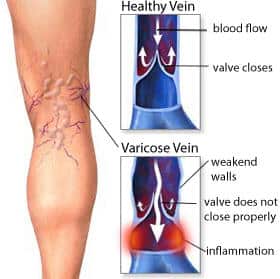
What are Varicose Veins?
Veins and arteries, while both parts of the circulatory system, function quite differently from each other. “Poor circulation” is a nonspecific term that often refers to arterial blockages.
Arteries bring oxygen-rich blood from the heart to the extremities and can be thought of like a tube or hose. Veins, unlike arteries, have one-way valves and channel oxygen-depleted blood back toward the heart.
If the valves of the veins don’t function well, blood doesn’t flow efficiently. The veins become enlarged because they are congested with blood.
These enlarged veins are commonly called spider veins or varicose veins. Spider veins are small red, blue or purple veins on the surface of the skin. Varicose veins are larger distended veins that are located somewhat deeper than spider veins.
Varicose Veins Symptoms
Pain in the legs is frequently related to abnormal leg veins. Symptoms, often made worse by prolonged standing, include feelings of fatigue, heaviness, aching, burning, throbbing, itching, cramping, and restlessness of the legs. Leg swelling can occur. Severe varicose veins can compromise the nutrition of the skin and lead to eczema, inflammation, or even ulceration of the lower leg.
Causes of Varicose Veins
Heredity is the number one contributing factor causing varicose and spider veins. Women are more likely to suffer from abnormal leg veins. Up to 50% of American women may be affected. Hormonal factors including puberty, pregnancy, menopause, the use of birth control pills, estrogen, and progesterone affect the disease. Other predisposing factors include aging, standing occupations, obesity and leg injury.
Diagnosing Varicose Veins
Vein disorders are not always visible; diagnostic techniques are important tools in determining the cause and severity of the problem. In addition to a physical examination, non-invasive ultrasound is often used.
Varicose Vein Treatment: What is the VNUS® Closure® Procedure?
The VNUS® Closure® procedure is a minimally invasive treatment for superficial venous reflux. A thin catheter is inserted into the vein through a small opening. The catheter delivers radiofrequency (RF) energy to the vein wall, causing it to heat, collapse, and seal shut.
How Does It Work to Treat Superficial Venous Reflux?
Since valves can’t be repaired, the only alternative is to re-route blood flow through healthy veins. Traditionally, this has been done by surgically removing (stripping) the troublesome vein from your leg. The VNUS® Closure® procedure provides a less invasive alternative to vein stripping by simply closing the problem vein instead. Once the diseased vein is closed, other healthy veins take over and empty blood from your legs.
Is the VNUS® Closure® Procedure Painful?
Patients report feeling little, if any, pain during the VNUS® Closure® procedure. Your physician will give you a local or regional anesthetic to numb the treatment area.
How Soon After Treatment Will My Symptoms Improve?
Most patients report a noticeable improvement in their symptoms within 1-2 weeks following the procedure.
Are There Any Potential Risks and Complications Associated With the VNUS® Closure® Procedure?
As with any medical intervention, potential risks and complications exist with the VNUS® Closure® procedure. All patients should consult their doctors to determine if their conditions present any special risks. Your physician will review potential complications of the VNUS® Closure® procedure at the consultation, and can be reviewed in the safety summary. Potential complications can include: vessel perforation, thrombosis, pulmonary embolism, phlebitis, hematoma, infection, paresthesia (numbness or tingling), and/or skin burn.
Is the VNUS® Closure® Procedure Suitable for Everyone?
Only a physician call tell you if the VNUS® Closure® procedure is a viable option for your vein problem. Experience has shown that many patients with superficial venous reflux disease can be treated with the VNUS® Closure® procedure.
How effective is the VNUS® Closure® procedure?
Published data suggests that two years after treatment, 90% of the treated veins remain closed and free from reflux, the underlying cause of varicose veins.
Is the VNUS® Closure® treatment coverd by my insurance?
Many insurance companies are paying for the VNUS® Closure® procedure in part or in full. Most insurance companies determine coverage for all treatments, including the VNUS® Closure® procedure, based on medical necessity. The VNUS® Closure® procedure has positive coverage policies with most major health insurers. Your physician can discuss your insurance coverage further at the time of consultation.
Read the Reviews!
"I've been seeing Dr. Zakhary for my vein issues for a long time. He explains about the plan of care & treatment he is going to do. He is kind, courteous and very dedicated to all his patients. He wants to give all his patients the best quality of life to live each day. His staff are great and caring they give that special touch to each patient. I highly recommend seeing Dr. Zakhary for any circulation issues you have."
How is the VNUS® Closure® procedure different from vein stripping?
During a stripping procedure, the surgeon makes an incision in your groin and ties off the vein, after which a stripper tool is threaded through the saphenous vein and used to pull the vein out of your leg through a second incision just above your calf.
In the VNUS® Closure procedure, there is no need for groin surgery. Instead, the vein remains in place and is closed using a special (VNUS® Closure®) catheter inserted through a small puncture. This may eliminate the bruising and pain often associated with vein stripping (i.e., that may result from the tearing of side branch veins while the saphenous vein is pulled out).

Vein stripping is usually performed in an operating room, under a general anesthetic, while the VNUS® Closure® procedure is performed on an outpatient basis, typically using local or regional anesthesia.
Three randomized trials of the VNUS® Closure® procedure vs. vein stripping, including the most recent multi-center comparative trial, show very similar results. In the multi-center comparative trial, the VNUS® Closure® procedure was superior to vein stripping in every statistically significant outcome. In the study, 80.5% of patients treated with the VNUS® Closure® procedure returned to normal activities within one day, versus 46.9% of patients who underwent vein stripping. Also, VNUS® Closure® patients returned to work 7.7 days sooner than surgical patients. Patients treated with the VNUS® Closure® procedure had less postoperative pain, less bruising, faster recovery, and fewer overall adverse events.
How long does the VNUS® Closure® procedure take?
The VNUS® Closure® procedure takes approximately 45-60 minutes, though patients normally spend 2-3 hours at the medical facility due to normal pre- and post-treatment procedures.
Will the procedure require any anesthesia?
The VNUS® Closure® procedure can be performed under local, regional, or general anesthesia.
How quickly after treatment can I return to normal activities?
Many patients can resume normal activities immediately. For a few weeks following the treatment, your doctor may recommend a regular walking regimen and suggest you refrain from very strenuous activities (heavy lifting, for example) or prolonged periods of standing.
Is there any scarring, bruising, or swelling after the VNUS® Closure® procedure?
Patients report minimal to no scarring, bruising, or swelling following the VNUS® Closure® procedure.
Is and an important consideration for the VNUS® Closure® procedure?
The most important step in determining whether or not the VNUS® Closure® procedure is appropriate for you is a complete ultrasound examination by your physician or qualified clinician. Age alone is not a factor in determining whether or not the VNUS® Closure® procedure is appropriate for you. The VNUS® Closure® procedure has been used to treat patients across a wide range of ages.
What happens to the treated vein left behind in the leg?
The vein simply becomes fibrous tissue after treatment. Over time, the vein will gradually incorporate into surrounding tissue. One study reported that 89% of treated veins are indistinguishable from other body tissue one year after the VNUS® Closure® procedure was performed.
What are patients saying about the VNUS® Closure® procedure?
98% of patients who have undergone the VNUS® Closure® procedure are willing to recommend it to a friend or family member with similar leg vein problems.
Schedule a Consultation
If you're interested in learning more about Varicose Veins & the VNUS® Closure® procedure please contact us for a consultation at (623) 258-3255 or fill out our contact us form here. Dr. Zakhary will discuss your needs and concerns, and determine your best course of action.
